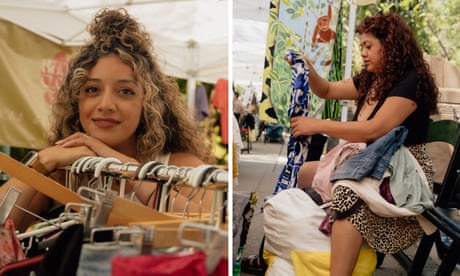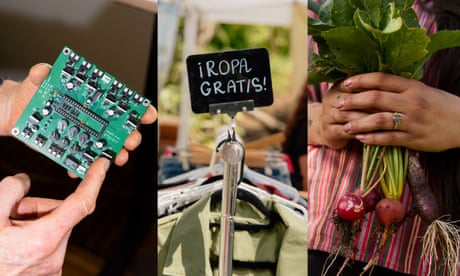I swapped my south LA lawn for a verdant microfarm – now I feed the neighborhood
- Read more from The DIY Climate Changers, a new series on everyday people’s creative solutions to the climate crisis
Victoria NamkungWed 15 May 2024 10.00 EDTShare
Beverly Lofton’s home in south Los Angeles used to have a water-guzzling grass lawn. Today, it’s a verdant microfarm that uses solar power and recycled water to grow carrots, beets, potatoes and more, with the bounty distributed to her neighbors. The 67-year-old’s switch was a bold move in a city ruled by cars and concrete, and where the impact of extreme heat and water shortages are acutely felt. It’s also a powerful rebuttal to food insecurity and big agriculture, in a neighborhood considered a “food desert”.
Imoved to South Los Angeles’s Hyde Park neighborhood in 1988. At the time, my future husband lived in the house next door. That’s how we met. I moved in with him 1989 and have lived in that house since – it was the easiest move I ever made.

In 2020, during the pandemic, I connected with Crop Swap LA, a local group that turns unused spaces like front lawns into sustainable microfarms in a way that creates jobs and preserves water – and then equitably distributes the food grown on them. Their goal is to have microfarms in places hardest hit by food insecurity and food apartheid. My neighborhood has been called a food desert. Grocery stores and other stores keep closing, while more and more apartment-style housing is being built.
We started the conversion in 2021 and we celebrated the grand opening in 2022. A lot of people are always walking by with their dogs and their kids in strollers so they see the progress – it’s always a moment of conversation. Crop Swap LA took out all of the grass and I was able to get a $4,500 rebate from the Los Angeles department of water and power for the turf that was removed.

They put in a reservoir and six raised beds and a drip irrigation system that uses recycled water. We’ve had so much rain lately and it all gets captured into the reservoir. Before the conversion, my front lawn was just basically grass, and with the drought and all the watering costs, the water bill was about $400 every other month. The bill I just got this week for water was $37.63 for two months, so it’s just an amazing amount of savings.
We’ve grown a lot of dark leafy greens, bok choy, collard greens, string beans. Crop Swap LA also grows carrots, beets, radishes, potatoes and anything that needs a deeper root system in grow bags called GardenSoxx. And we have a grapevine, so we’ll have Concord grapes this year. The microfarm is solar powered and has on-site composting. I was not surprised that all these things could grow, because when we remodeled our house in 2006, a crew tore up the grass and it came back. Anything with roots wants to grow on this land.
Knowing food grown in my front yard is feeding people in our neighborhood feels amazing
Beverly Lofton
Since the microfarm is part of Crop Swap LA, their team members come and maintain the garden a few times a week and I’ve gotten to know a lot of the workers. They harvest on Sundays, when I’m usually at church, and they often leave me samples of what was harvested that day. Crop Swap LA offers an affordable membership to neighbors within a one-mile radius of my house and they receive at least 2lb each week of freshly harvested vegetables and fruit.
Knowing food grown in my front yard is feeding people in our neighborhood feels amazing. Most people who see the microfarm are thrilled it’s in the community and they sometimes offer advice or stories about their gardening experience or desire to start planting. One gentleman stopped by to show me photos of his garden. It’s even better when Crop Swap LA workers are here because they can share their expertise and encourage everyone to participate in making our community better.

When I was a child, my grandparents lived 1.5 miles from where I am now and they had a beautiful garden in the backyard, but I never learned the science of planting, pruning and harvesting from them. I feel like I’ve redeemed myself. It’s very satisfying and I don’t understand why more people don’t do it, especially with the rebate program we have here. Hopefully I can be an example of what’s possible.

I retired in 2012 after working as a financial operations consultant for the Los Angeles county office of education. My husband passed away in 2016 so it’s just been me since then. After hearing the story of how I met my late husband, La Salle Lofton Sr, Crop Swap LA let me name the microfarm after him. La Salle loved to cook and also to feed people. He would have loved the idea of having a front yard garden to benefit our family and neighbors.
- The DIY Climate Changers is a series about everyday people across the US using their own ingenuity to tackle the climate crisis in their neighborhoods, homes and backyards. If you would like to share your story, email us at diyclimate@theguardian.com.